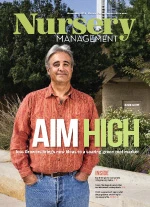 Joss Growers planted this green roof atop Austin City Hall. Joss Growers planted this green roof atop Austin City Hall. |
David Scott, owner of Joss Growers in Georgetown, Texas, has been fortunate to stay a few years ahead of the growing trends.
Scott started the business in his backyard in 1993 and moved to the Georgetown location in February 1994, where he was growing bedding plants. In the fall of 1996, Scott turned his attention to grasses and native plants, before drought-tolerant plants became such a valuable crop. In 2002 he added specimen succulents to the inventory. And in 2005, Scott discontinued bedding plants to devote his company's full attention to grasses and native species, six years before this year's record-breaking drought in Texas.
"The current drought is beyond severe and will forever change the plant palette in central Texas," Scott said. "That makes our decision in 2005 to specialize in drought-tolerant grasses and native species a smart move. We are well positioned to meet the challenges of landscaping in Texas in 2012 and beyond."
Green roof introduction
And it was Scott's expertise in drought-tolerant plants that got him involved in green roofs. In 2003, The Lady Bird Johnson Wildflower Center asked Joss Growers to supply some plants for the center's green roof test beds.
"That got me thinking about green roofs as a new market," Scott said. "I did my homework, and I found out that green roofs were pretty well-established in the northern tier states."
 Joss Growers focuses on natives and drought-tolerant species, a strategic move with the intense drought that hit Texas this year. Joss Growers focuses on natives and drought-tolerant species, a strategic move with the intense drought that hit Texas this year. |
But the southern states hadn't embraced the idea yet. This led to a new market for Joss Growers' drought-tolerant grasses and native plants.
In 2005, Joss supplied plants for green roofs on Austin City Hall and an Austin Starbucks. In 2007, the grower planted a large green roof in West Austin.
"They did not use a manufactured growing medium. They used soil mined from the river bottom, and we sold a variety of plants to help make that work," Scott said.
After the West Austin project, Scott traveled to a trade show in Vancouver where he first saw the LiveRoof Hybrid Green Roof System and its module design. LiveRoof, based in Spring Lake, Mich., manufactures a green roof system.
"I knew this was the product I wanted to sell to my customers," he said. "LiveRoof establishes a green roof as a naturally functioning ecosystem with the soil unified between modules across the rooftop. I could see it would install easily and seamlessly and, most importantly, that it would work."
LiveRoof's model consisted of the same type of plants for all of its projects. But when LiveRoof was hired to construct a green roof in Dallas in 2011, the company needed help from a Texas grower to work out the kinks. After all, Texas has some pretty severe weather, including much higher temperatures than those in the North and East where many LiveRoof projects had been completed.
"LiveRoof wanted my advice on what type of plants would work with their system at this location," Scott said. "Their business development manager came down to visit our nursery. She came away with a good sense of our business, our operations and our plants. Soon after, LiveRoof invited us to join their national network of licensed regional growers."
 Joss Growers uses a mix of xeric groundcovers, succulent perennials and short-stature grasses for green roof installations. Joss Growers uses a mix of xeric groundcovers, succulent perennials and short-stature grasses for green roof installations. |
Green roof plants
The majority of green roofs in the U.S., Canada and Europe are planted with sedums. But the brutal Texas heat and often dry conditions aren't conducive to using sedums.
"We won't be using any sedums on LiveRoof installations in Texas," Scott said. "We will have a mix with plenty of xeric groundcovers, several ice plants, succulent perennials with good colors, and a few short-stature grasses. This type of mix has already been proven on green roofs in Central Texas."
.jpg)
Scott has some advice for any grower who wants to enter the green roof market.
"The rooftop is an unforgiving environment for plants. That makes your knowledge of local conditions essential for figuring out what plants are best for particular projects," he said.
It's also important to know that most of the growing media in green roofs are 80-90 percent inorganic material, so they do not decompose or settle very much, he said.

"Peat-based soil with compost and perlite will decompose and wash away during rains and blow away when it is dry and windy. The volume of material in that kind of mix will shrink, and a year after installation, the green roof will look long gone," he said.
Not all green roofs are created equal, or are equally green, he said.
"Most green roof systems have been designed by people in the roofing business, not people rooted in horticulture," Scott said. "Growers ought to look for green roof manufacturers who can see the rooftop environment as a biological system, who understand that a green roof has to be green — a horticulturally sound, sustainable system designed so plants will flourish."

For more: www.jossgrowers.com.
Get curated news on YOUR industry.
Enter your email to receive our newsletters.
Explore the November 2011 Issue
Check out more from this issue and find your next story to read.
Latest from Nursery Management
- [WATCH] Winter is coming...but spring will bring disease
- Sam Hoadley talks about Mt. Cuba Center's latest evaluation of Solidago sp. for the Mid-Atlantic region
- Prices & Market Segments
- Countdown to shutdown
- All in the family
- From growing plants to growing people
- Weed Control Report
- Advocacy in action






